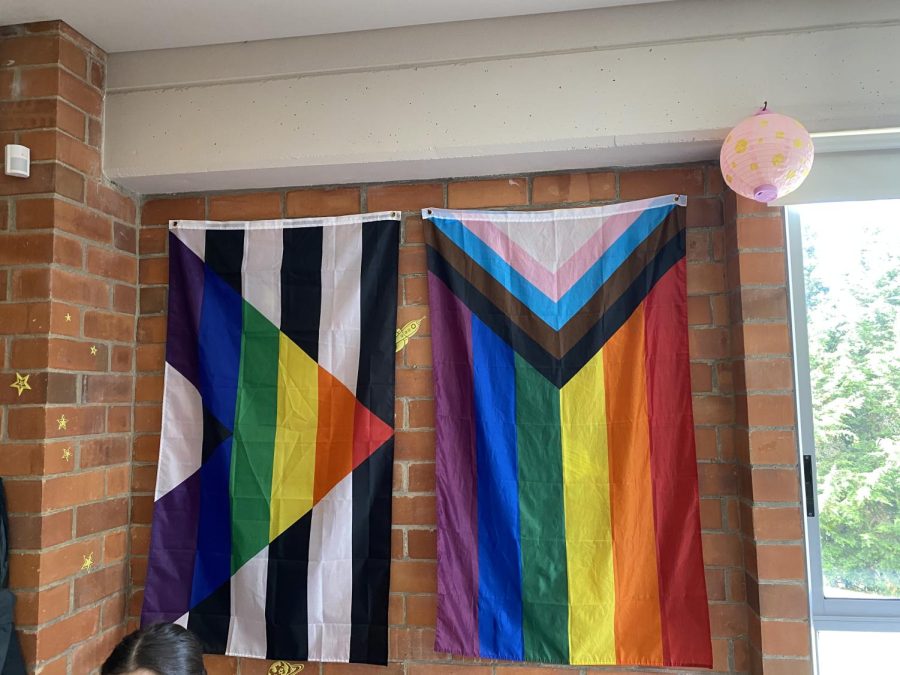Pride Flags cause controversy
A flag representing the LGBTQ+ community and the Gay-Straight Alliance hang in a high school classroom.
Walking through the hallways, you see multiple Pride Flags displayed in different classes. When you ask the teacher who owns the flag, they will speak to you about inclusion and representation. However, some families view this as a threat to their children’s identity.
Many people perceive flags as mere pieces of cloth; nonetheless, they represent the symbol or emblem of a country, community, or institution. In school, there is an ongoing controversy surrounding the Pride Flags, causing confusion among individuals who question whether these should be hung.
“The world is in a time of development and we cannot always be stuck on the same things, so we need to be open and become inclusive,” Senior, Luisa Ceballos, said.
In many classrooms, especially in HS, the Pride Flag is exhibited permanently. Concerns have risen among the parents who worry about the influence on their children’s identities, causing confusion between the students and distress for some teachers. Therefore, multiple meetings have occurred to discuss the topic.
One teacher who attended the meeting felt that the alumni were overall on board. They expressed concerns about having flags up in elementary classrooms, but regarding Middle School and High School, many wondered “Why are we even having this conversation?”
Internationally, other schools also face this type of controversy where students, school officials, and parents have banned Pride Flags as a political symbol and ordered teachers to remove them from their classrooms. In schools in Utah, Oregon, Missouri, Texas, and Florida LGBTQ+ symbols are being called political and disharmonious. Here, families express their discomfort towards the Pride Flags communicating their exclusion from the community.
In a letter sent by ASOPAF to the school administration on December 13th, 2022 they expressed concerns about how the flag of the LGTBIQ+ community is exposed permanently in many school classrooms. Although it belongs to a community that they accept and respect, they requested them to be withdrawn to preserve as much as possible “healthy neutrality and equity in the classrooms because those of us who are not part of this community, feel excluded and in inequality of expression.”
In the ongoing meetings regarding the subject, the school directives have approached it by standing by the school’s principles which include equality, acceptance, and open-mindedness.
“Within a framework based upon the concept of fundamental human rights, and in the agreement of our institutional practices and values, we are an inclusive school. We defend the right to freedom of expression, and as an institution, we support, value, and accept members of diverse communities, including the LGBTIQ+ community,” Dr. Ruth Allen, School Superintendent, said.
The issue revolves around the parents believing their children’s sexual orientation could be impacted and swayed because of the flag’s constant display around the institution.
“Some parents have expressed a concern that some teachers could be inciting or inducing the students to review their identity or sexual orientation,” Dr. Allen said.
Many parents discuss the subject at home where they communicate their views on the issue to their children. Therefore, various students slowly learn about the controversy currently surrounding the LGBTQ+ community at school, forming their opinions regarding the issue.
“I thought it was weird, having in mind that there is a club called the Straight-Gay Alliance in our school, where they have meetings to educate us all about some topics that need to be discussed,” Ceballos said.
Ceballos is not the only one confused. Some students have arguments to present and believe the contrary to their parents who firmly stand against the display of the flags.
“I honestly think it’s completely fake and kind of ridiculous because as you know, we’re really smart. We know what we like. We know what we don’t like. Because we look at a flag and we try to accept people that feel differently, it doesn’t mean we’re going to change our own identity,” María Echeverri, Grade 11, said.

High School Physics Teacher Gurveer Brar’s classroom door, represents equality and knowledge.
The school directives have expressed concern about the effect of the debate within the community and attempted to resolve it by speaking openly about equality. TCS advocates for its values and expresses concern about this being an ongoing issue in the 21st century.
“Although our teachers handle issues of diversity, inclusion, and equity in general terms, they do not manage issues directly related to the sexuality of the individual,” Dr. Allen said.
Many teachers have also communicated their concerns regarding the parent’s statements and stand by the side of inclusion, acceptance, and unity.
“The Pride Flag is really a flag that helps our LGBTQ+ students feel accepted, feel welcomed, feel like they’re part of the community because that’s extremely important. So when I hear that there’s issues with the flag. It’s concerning to me,” Gurveer Brar, AP Physics Teacher, said.
While tensions between parents and the school have largely diminished, discussion of the school’s role in promoting equity and inclusion will likely continue.
“This is a school known for its openness, so it does not make sense that sexuality has become controversial or political as it is not a choice. The LGBTQ+ students should feel safe and supported at school,” Echeverri said.




